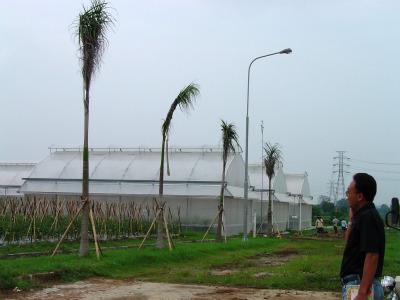
Sept. 14, 2011, Wageningen, the Netherlands — It is possible to build
greenhouses with relatively simple means in tropical lowlands regions in
which crops can be protected against winds and pests, and can be grown
at practically the same temperature as outside.
Sept. 14, 2011, Wageningen, the Netherlands — It is possible to build greenhouses with relatively simple means in tropical lowlands regions in which crops can be protected against winds and pests, and can be grown at practically the same temperature as outside.
The result is healthier crops, higher yields and better and healthier products. This was shown in research with which Mr. Impron hopes to obtain his doctorate from Wageningen University, part of Wageningen UR.
In tropical lowlands, crops growing outside are frequently destroyed by torrential rainfall, diseases or pests. Under such conditions food crops produce a limited yield, while the resulting products contain excessive levels of pesticide residues. The irony is that many of these regions have more than enough sunlight and water available.
Wageningen scientists used computer models to develop a greenhouse type that makes it possible to maintain almost the same temperature inside the greenhouse as outside without the need for expensive high-tech cooling systems, which normally consume a great deal of energy. For that development, they used their well-known “adaptive greenhouse” concept, in which they take local factors like weather conditions into account.

|
| Impron, a Wageningen PhD candidate, coordinated Indonesian research on the new greenhouse. PHOTO COURTESY WUR |
The scientists developed a greenhouse that can be built with locally available materials. They used a plastic type that partly insulates the greenhouse against the outside heat. The design also makes the most of the natural “chimney effect” of the greenhouse and the cooling effect of the plants themselves. Plants can slightly cool their own tissue and surroundings by evaporating a lot of water. By absorbing the water required for evaporation, plants can extract sufficient nutrients from the soil.
Impron, who hails from Indonesia, carried out research in a newly designed Wageningen greenhouse in his home country. He spent two years in Indonesia studying the climate in the new greenhouses, comparing the results of various roofing options with the computer predictions. He also compared the growth and development of so-called bush-tomato plants inside the greenhouse with those planted outside.
Impron found that the computer models were a good way to predict the climate in the new greenhouses. The best possible ratio of greenhouse length, width and height proved to depend on the wind speed. In places with little wind, the greenhouses need to be kept relatively narrow and long in order to retain the chimney effect required for sufficient “ventilation” of the warm and moist air.
The new greenhouses offer enormous benefits in terms of tomato yields, Impron discovered. While plants growing outside can quickly die as a result of disease and bad weather, they positively flourish within the greenhouse. The plants stay healthy and produce large numbers of good quality tomatoes. Moreover, with virtually no pesticides required, the resulting products are also healthier.
According to Impron, the basic Wageningen design can also be used to develop greenhouses for other tropical countries. The Department of Agriculture in Malaysia has already constructed a similar greenhouse.
Impron carried out this research on the island of Java at the premises of PT East West Seed Indonesia. The greenhouses were built by Rovero Systems BV and the new insulating plastic roof was made by Oerlemans Plastics BV and Plasthill BV, all three of which are based in the Netherlands. The research was co-financed by the Dutch government.
Print this page
